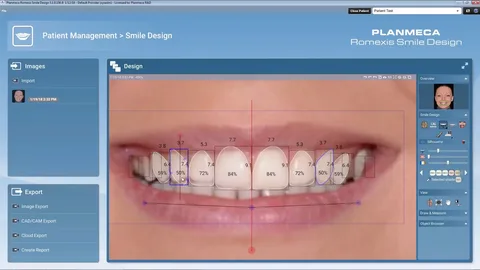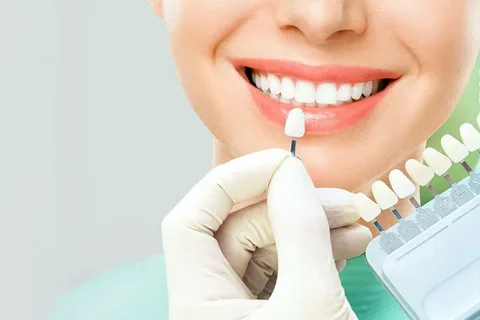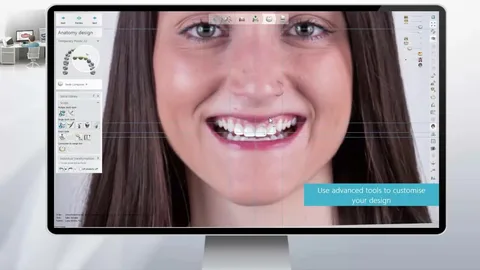Smile Design: Transforming Your Smile for a Confident You
Smile design is a comprehensive dental approach that combines both art and science to enhance the appearance of your smile. It involves customizing the shape, color, size, and alignment of your teeth to create a harmonious and aesthetically pleasing smile that complements your facial features. Using advanced technology and techniques, smile design focuses not only on the teeth but also on the gums and overall facial aesthetics to achieve a natural and balanced look.
Smile Design: Transforming Your Smile for a Confident You
Smile design is a comprehensive dental approach that combines both art and science to enhance the appearance of your smile. It involves customizing the shape, color, size, and alignment of your teeth to create a harmonious and aesthetically pleasing smile that complements your facial features. Using advanced technology and techniques, smile design focuses not only on the teeth but also on the gums and overall facial aesthetics to achieve a natural and balanced look.
What is Smile Design?
Smile design is a cosmetic dental procedure that focuses on improving the appearance of your smile through a combination of treatments, including teeth whitening, veneers, crowns, dental bonding, and gum reshaping. The goal is to achieve a smile that enhances your facial harmony and boosts your confidence. Smile design can address various cosmetic concerns, such as crooked teeth, stained teeth, missing teeth, uneven gum lines, and more.
Key Factors in Smile Design
Facial Aesthetics: Smile design takes into account your overall facial structure, skin tone, and lip shape. The goal is to ensure that the new smile complements the natural contours of your face.
Proportions of the Teeth: The shape, size, and alignment of your teeth play a crucial role in smile design. A balanced and symmetrical smile is often achieved by adjusting the teeth to match the ideal proportions.
Gum Health and Contour: Healthy gums are essential for a beautiful smile. If your gums are uneven or receding, gum contouring or reshaping may be part of the smile design process to create a balanced gum-to-tooth ratio.
Color and Shade of Teeth: Teeth whitening or veneers can be used to enhance the color of your teeth, making them appear brighter and more youthful. The shade chosen should blend seamlessly with your natural skin tone and overall appearance.
Functional and Aesthetic Considerations: Besides aesthetics, smile design also focuses on the functional aspects of the teeth, such as bite alignment and occlusion. A well-functioning smile is just as important as its appearance.
The Smile Design Process
Initial Consultation: The smile design process begins with a detailed consultation with a cosmetic dentist. During this appointment, the dentist will assess your oral health, discuss your goals, and determine the best treatment options to meet your needs.
Digital Smile Design (DSD): In many cases, digital tools are used to create a preview of your new smile. Using photographs, digital scans, and 3D imaging, the dentist can simulate the results of the proposed treatment and provide a visual representation of the final outcome.
Treatment Planning: Based on the consultation and digital design, the dentist will create a personalized treatment plan that may involve various procedures, such as teeth whitening, veneers, dental bonding, crowns, gum reshaping, or orthodontics.
Procedures and Treatment: The treatment process may vary depending on the procedures involved. Some treatments, like teeth whitening or bonding, can be completed in a single visit, while others, such as veneers or crowns, may require multiple visits.
Follow-Up and Maintenance: After the smile design procedures are completed, regular follow-up visits may be necessary to ensure that everything is healing correctly. The dentist will provide guidelines for maintaining your new smile and offer tips on oral care to ensure long-term success.
Benefits of Smile Design
Enhanced Aesthetics: Smile design results in a brighter, more symmetrical, and youthful smile that can enhance your facial appearance and boost your confidence.
Personalized Results: The treatment is customized to fit your unique facial features, ensuring that your smile complements your overall appearance in a natural way.
Improved Functionality: In addition to cosmetic benefits, smile design may also improve the function of your teeth, including bite alignment and comfort.
Long-Lasting Results: The materials used in smile design, such as porcelain veneers and crowns, are durable and can last for many years with proper care, providing a long-term solution for an enhanced smile.
Non-Invasive Options: Depending on your needs, smile design may offer non-invasive or minimally invasive procedures, such as teeth whitening or bonding, that don’t require significant alterations to the teeth.
Who Can Benefit from Smile Design?
- Those with Stained or Discolored Teeth: Smile design can brighten the teeth, improving the color and overall appearance of your smile.
- Individuals with Misaligned or Crooked Teeth: Cosmetic treatments such as veneers or Invisalign can straighten teeth and improve the overall alignment.
- People with Missing Teeth: Smile design offers solutions like implants, bridges, or dentures to replace missing teeth and restore your smile.
- Those with Gummy Smiles: Gum contouring can address an uneven gum line and make your smile more proportional and balanced.
- Anyone Looking for a Confidence Boost: Smile design is an ideal option for those looking to enhance their smile for aesthetic purposes and feel more confident.
Key features about Smile Design

Personalized Treatment Plan

Comprehensive Aesthetic Enhancements

Use of Advanced Technology
Frequently asked questions
Here are descriptions for FAQs about Root Canal Treatment (RCT) to provide a clear understanding:
Smile design is a cosmetic dental procedure that aims to improve the appearance of your smile by addressing factors such as tooth alignment, color, shape, size, and gum contours. It customizes treatments to enhance your facial aesthetics and boost your confidence.
Anyone looking to improve the appearance of their smile due to issues like stained, misaligned, or missing teeth, uneven gum lines, or a gummy smile can benefit from smile design. A consultation with a cosmetic dentist will help determine if you are a suitable candidate.
Smile design may involve various procedures, such as teeth whitening, veneers, crowns, dental bonding, gum reshaping, orthodontics, or implants, depending on your specific needs.
Most smile design treatments are minimally invasive, with local anesthesia used during procedures to ensure comfort. Some treatments, like veneers or crowns, may involve mild discomfort during recovery, but pain is usually manageable.
The duration of smile design depends on the complexity of the procedures involved. Simple treatments like teeth whitening or bonding can be completed in a single visit, while more extensive procedures may take several visits over a few weeks.

